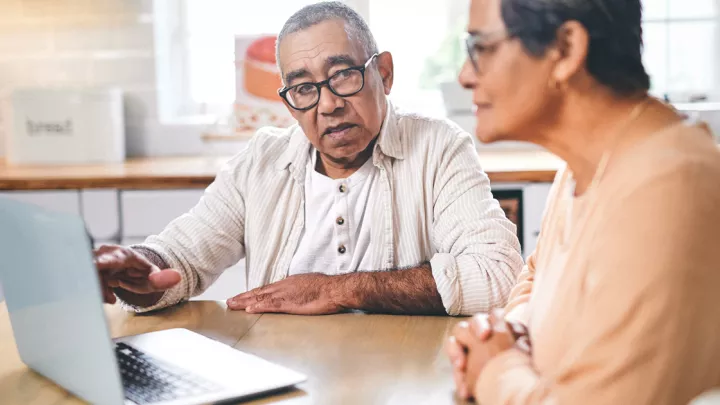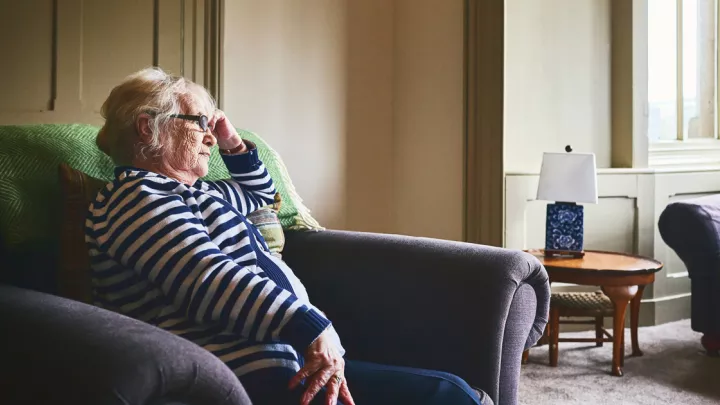COVID lung fibrosis: What is it, and is it reversible?

After millions of COVID-19 cases, lung fibrosis is on the rise. Pulmonologist and intensive care doctor John Dickinson, MD, PhD, helps people overcome lung fibrosis and get back to breathing normally again. Here Dr. Dickinson answers frequently asked questions about lung fibrosis.
What is lung fibrosis?
First things first, what is it? "Lung fibrosis refers to scarring of the lung, usually after infection or inflammation," says Dr. Dickinson.
"Lung tissue usually acts like a sponge – it opens and closes to exchange oxygen and carbon dioxide. In lung fibrosis, that process is limited," explains Dr. Dickinson. "The scar tissue makes the lung stiffer and less flexible than it needs to be. As a result, oxygen levels are lower than they should be."
Symptoms of lung fibrosis include:
- Shortness of breath
- Cough
Can lung fibrosis show up on an X-ray?
"You can see pulmonary fibrosis on an X-ray, but we typically use a high-resolution CT or CAT scans," says Dr. Dickinson.
Does lung fibrosis spread?
Lung fibrosis can develop:
- All at once, due to illness like pneumonia or COVID-19
- Over time, due to combination of genetic and environmental factors like pollution or cigarette smoke
If fibrosis is due to COVID-19, the scarring may be persist from a long time and then slowly resolve.
If an ongoing issue is the cause, like smoking, the scarring gets progressively worse over time.
What is post-COVID fibrosis?
Long COVID-19 (also called post-COVID) is defined as new or current symptoms that persist 30 days after initial COVID-19 infection. One of the potential consequences of long COVID is post-COVID fibrosis which can be seen on lung imaging by CT scan.
However, some Long COVID patients have clear symptoms, like shortness of breath, yet their scans appear normal. "Shortness of breath from Long COVID is very subtle on the CT scan, and sometimes abnormalities are not seen at all. Sometimes we can only detect abnormalities by doing a lung function test," says Dr. Dickinson. "This can be very frustrating for patients. There could be disease deep in the lungs that the standard lung CT doesn't show."
How does COVID-19 cause pulmonary fibrosis?
"Pulmonary fibrosis is a very broad term," says Dr. Dickinson. "People fall into different categories after COVID-19 infection."
Very severe COVID-19 causes tissue damage
People who need intensive care or have had acute respiratory distress syndrome or ARDS, often experience severe lung dysfunction. ARDS can lead to inflammation or fibrosis in the lungs. These COVID-19 survivors tend to have persistent abnormalities on lung imaging six months to a year after their infection. Some have persistent lung dysfunction, which shows up on pulmonary function testing. And others still need oxygen up to a year or more after their infection. This form of pulmonary fibrosis isn't progressive.
Less severe COVID-19 causes airway damage
Other patients had COVID-19, but not a severe case. Their lung fibrosis may be located in their small airways and blood vessels and is harder to detect. They have a persistent cough and shortness of breath. Often, they had pre-existing conditions, like asthma, that was made worse by COVID-19.
Is post-COVID lung fibrosis reversible?
"For most people, their symptoms from lung fibrosis improve back to baseline," says Dr. Dickinson. "It's a slightly different scenario for everyone. I haven't encountered anyone yet who has developed progressive lung fibrosis from COVID-19 that's irreversible."
University of Nebraska Medical Center researchers are part of the NIH RECOVER study to understand long COVID, including Dr. Dickinson, David Warren, PhD, and principal investigator Andrew Vasey, MD. "We're using extensive testing and lung imaging to study long COVID, especially unexplained breathlessness," says Dr. Dickinson.
Is lung fibrosis curable? How to treat lung fibrosis
Treatment depends on whether the damage is in the lung tissue or the lung airways.
Lung tissue damage: "Prolonged courses of steroids – up to three months – may help for people who had a critical illness like ARDS due to COVID-19," says Dr. Dickinson. "For others, we may support them with oxygen and pulmonary rehab. An inhaler can improve bronchodilation. Things gradually improve with time."
Lung airway damage: "For the people who have issues with smaller airways, we treat with inhaled steroids and bronchodilators to improve airflow to the lungs. It's similar to how we'd treat asthma," explains Dr. Dickinson.
New drugs – called anti-fibrotic agents – may slow the progression of idiopathic pulmonary fibrosis. This is an active area of clinical research. It is not known if these agents aid in the resolution of pulmonary fibrosis from infections such as COVID-19.
While lung fibrosis in some patients may persist for some time, encouragingly it does gradually improve rather than progress to end-stage lung disease.






